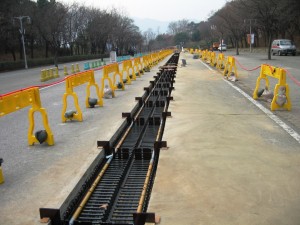A wirelessly charged electric vehicle went into service last week at the Seoul Grand Park in Gwacheon, traversing a 2.2 kilometer-long circular route through the zoo.
Known as on-line electric vehicle (OLEV), the jitney is powered by electricity from an electrical charging strip planted about 5 cm under the road surface, with a 13 cm gap between the road surface and the vehicle.
It is in pilot operation at the theme park, replacing diesel powered shuttle trains that ran on diesel fuel.
The OLEV, developed by the Korea Advanced Institute of Science and Technology (KAIST), is charged wirelessly over a 400-meter long stretch of electrical strip. A special electrical strip creates a magnetic field that generates magnetic force, which is sent wirelessly to the vehicle and converted into electricity.
Similar vehicle demonstrations from other companies have failed in the United States and elsewhere.
The first KAIST OLEV was built and the electrical strips were laid in January. Numerous safety evaluations and test runs to improve efficiency have been conducted since then.
It’s claimed that tests show that the magnetic field used in the system poses no health risks.
By using “segmentation technology,” which provides electricity in sections, the amount of magnetic field generated is minimized.
During a month-long test run in February the magnetic field generated was measured below the international standard of 62.5 mG, the city of Seoul said in a statement.
The Seoul Metropolitan Government plans to introduce OLEVs as part of its public bus transportation system. With buses responsible for about 30% of transportation demand, and median bus lanes in place in 25 areas totaling 90.2 kilometers, wirelessly charged electric buses are an attractive “green alternative” for Seoul.
The KAIST-developed OLEV is said to be commercially viable because it uses a lighter battery than other concepts, and because it does not require an extended standby time for charging.
Seoul is pioneering the use of “green cars” in the country, and believes the OLEV is a solution to Seoul’s traffic problems. Projects for this year include deciding the routes and building charging stations. the city plans to deploy “green cars” in all its public transportation systems, including taxis and buses, by 2020, in an effort to improve air pollution and curb greenhouse gas emissions. The city government’s fleet of official cars will also be replaced by green cars.


